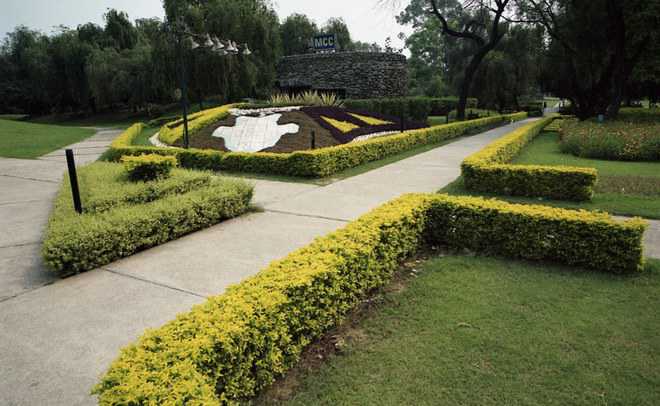Maninder Singh
Le Corbusier, whose name remains forever mingled and wedded with that of Chandigarh, called the gardens and parks running through the heart of the city as the lungs of the garden-green city. Of the parks built by the founder-architects and city planners, there is perhaps none as sylvan and well-wooded than the Japanese Garden or the Shanti Kunj in Sector 16.
None of the other gardens are abuzz with as much bird life as the Shanti Kunj. There are a large number of peacocks that make free use of the heritage government houses that line the north-western border of the garden. Besides peacocks, pigeons, parakeets, hawks, eagles and the rare pair of hornbills — the state bird of the city— there is even a family of red jungle fowl, six-seven of them, living splendidly off the natural habitat. I guess they must have migrated to this fair garden through the silk route of the N-choe stream that flows from Sector 1, the largest sector in Chandigarh, closest to the Shivalik hills.
The letter N stands for ‘Natural’ and this was the stream that was so designated in the first survey map of the yet to be built city in 1950-51. You may still see the original survey map in the Government Museum in Sector 10. This N-choe wends its merry, winding way through the parks, starting from Bougainvillea Park in Sector 3, much in the manner of the “rolling English road”.
In the poem of the same name, GK Chesterton wrote of how the “rolling English drunkard” made the rambling mazy roads of England. And, N-choe, likewise, is winding, mazy and rambling. Sad to say, the old channels that kept the N-waterway supplied, have been cut off over the years. Barring the wet season, the N-choe is largely dry for the rest of the year.
In the houses adjoining the park, live and have lived some of the senior most officers and dignitaries of the city. MN Sharma, the first Indian chief architect of the city, who worked in that position for 15 years, lived in No. 514 for many years in the 70s and 80s.
Neerja Bhanot, the brave Chandigarh girl, who took on the hijackers of the Pan Am Flight 73 and saved the lives of so many passengers, used to live in No. 520 with her parents and her brothers. Her father worked for the Hindustan Times in those days. That lovely girl grew up in that house and lived there right up to the time she went to work in Mumbai.
Rajesh Khullar, Principal Secretary to the Haryana CM, lives in the adjoining house No. 518 now and once said his preparations for the civil services were primarily made in the solitude of the Shanti Kunj. When he would leave at sunset, he would roll up his floor rug, and hide it up in the leafy branches of a tree.
Former UT Finance Secretary, Sarvjit Singh, stays in No. 510, and in winter, during government notified holidays, can be seen meditating and sunning himself, while peacocks forage the garden, and his Persian cats gracefully arch their backs and saunter in and out.
Down the lane, the very last house on the row adjacent to Shanti Kunj, is an ancient construction and reminds of the most famous words in fiction— “Last night, I dreamt I went to Manderley again. It seemed to me I stood by the iron-gate leading to the drive, and for a while, I could not enter, for the way was barred to me.” The path was, indeed, barred by wild shrub, creepers, trailers and old trees. Long ago, there was a family of three that lived there – a mother and her two daughters. One day, even they were gone, one heard, to Canada.
The Japanese Garden was the site of many pranks and joyous occasions, when we were in school and college. We used to run and walk there and trudge it innumerable times, in a short-cut to Sector-17 Plaza, especially to Neelam Theatre, which sometimes used to screen English films as well in those days. I saw “Lawrence of Arabia” there with two of my merriest schoolboy companions. One of them had access to his father’s old Mercedes, and we used to drive up in great style.
There is a pump-house in the park, right upfront, as you walk in from the Rose Garden. There are metal footholds to climb up to the roof and our rowdy friends used to indulge themselves with lager and home-made sandwiches. Once, there was a murder in the garden. All the government houses have a room overlooking the back of the house and the park. One early evening, as we looked down, we saw the bobbing lights of a two-wheeler, across the N-choe. We had no wicket-gates nor a mighty back wall but only a gap in the hedge, across which we stepped into the park.
We were planning to walk to the Sector 17 market place that day, and God alone knows, why we didn’t. For long, we wondered what would have happened if we had gone, because a body was found next morning along the N-channel, 50 meters from the house where we lived. Thereafter, we got somewhat wary of walking into the Japanese Garden at night. Much did we wonder what we would have encountered if we had walked into the park that night? Could we have perished ourselves? Would we have succeeded in saving that hapless man’s life?
Quoting again the poet GK Chesterton: “For there is good news yet to hear and fine things to be seen/Before we go to paradise…”
And may I be allowed to add, “Before we go to paradise/by way of Shanti Kunj.”
(The writer is Chairman, Chandigarh Housing Board)
Unlock Exclusive Insights with The Tribune Premium
Take your experience further with Premium access.
Thought-provoking Opinions, Expert Analysis, In-depth Insights and other Member Only Benefits
Already a Member? Sign In Now











